A Comprehensive Guide to the 48 Inch Skimboard
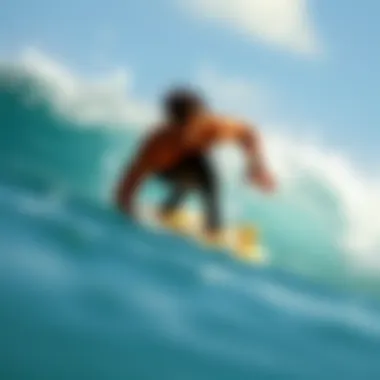
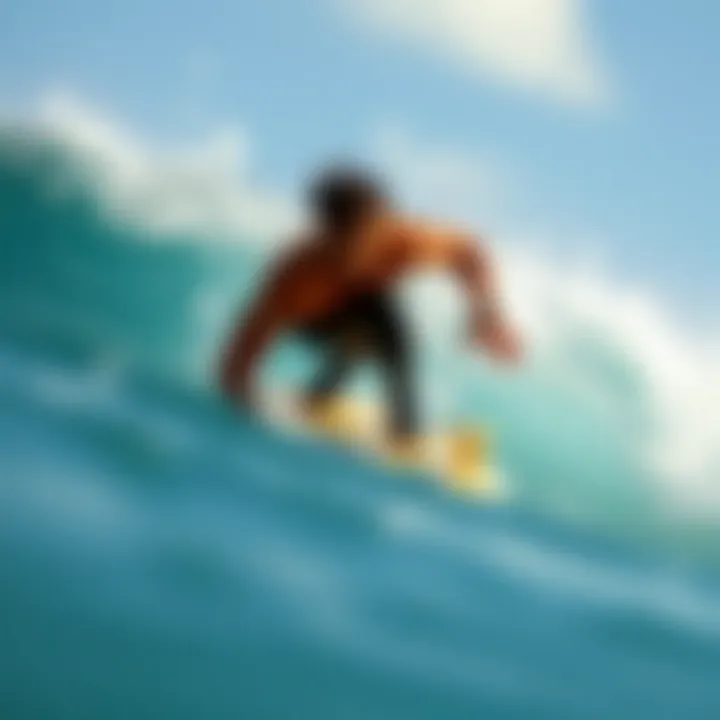
Intro
Skimboarding has carved a unique niche within the surfing community, offering both a thrilling ride and a communion with nature. At the heart of this activity lies the 48-inch skimboard, a size that strikes a balance between maneuverability and stability. Whether you are a newcomer testing the waters or an advanced skimmer executing complex maneuvers, understanding the intricacies of this particular model is essential for a rewarding experience.
This guide will take you through every facet of the 48-inch skimboard, from its design and materials to recommended techniques for different skill levels. The aim is to equip both amateurs and seasoned practitioners alike with knowledge and insights that will elevate their performance.
With an emphasis on practical application, you’ll discover how to choose the right board, improve your skills, and keep your equipment in prime condition. Let’s not waste any time; dive into the wonderful world of skimboarding while gaining a deeper appreciation for this thrilling sport.
Understanding Skimboarding
Skimboarding, at its core, is more than just a thrilling seaside activity; it's an art form that has evolved alongside the ocean waves it embraces. For anyone interested in heading into the world of skimboarding, understanding the nuances of the sport is crucial. With its unique elements, skimboarding offers not just a recreational outlet but also lessons in balance, timing, and interaction with nature. The experience of gliding across a thin layer of water requires a specific skill set and knowledge about the equipment, particularly when focusing on the 48-inch skimboard.
In this article, we aim to equip both newbies and seasoned riders with pertinent information to enhance their skimming experience. Learning about skimboarding can drum up a greater appreciation for the challenges and joys involved. Skimboarding isn't merely about chasing waves—it encapsulates enjoyment, physical engagement, and a strong sense of community among surfers and skimboarders alike.
The Basics of Skimboarding
A skimboard serves as your ticket to adventure along the shoreline. A person runs towards the water, drops the skimboard, and hops on it while skimming across the surface. Unlike surfing where a wave is required to take off, skimboarding often involves using a wave that rushes back to the ocean—a process sometimes referred to as "catching the receding wave." A 48-inch board, ideal for riders of various weights and skill levels, allows flexibility to maneuver easily on the water and practice various tricks.
Some basics include:
- Foot Positioning: Balance is paramount. Placing feet essentially at mid-board helps maintain stability while in motion.
- Knees Bent: Keeping knees slightly bent offers better control, especially during initial rides or when trying tricks.
- Practice, Practice: Gaining confidence on the board takes time; practice on flat surfaces and gradual slopes before attempting waves.
Getting these fundamentals right elevates your skimboarding skills significantly, making the thrill of gliding on water all the more vibrant.
History and Evolution of Skimboarding
Skimboarding, originating from the shores of Southern California, has a rich history. Initially, locals used wooden planks for riding along the coastline—a far cry from the sophisticated boards we see today. The practice began around the 1920s, where the primary aim was to skim along the wet sand after a wave had receded.
As the sport grew in popularity, especially during the 1970s, it underwent remarkable transformations. New materials emerged, and boards became lighter and more durable. Now, around the globe, skimboarding champions new materials like foam coatings and durable fiberglass, allowing for a diverse range of styles and performances. Additionally, today's skimboards are specifically designed for varying wave conditions and user experiences, fostering creativity and individuality in riding styles.
The evolution of skimboarding has paved way for competitions and events worldwide, enriching the culture and community surrounding the sport. Understanding this history not only highlights the journey skimboarding has taken but also illuminates how innovations affect the way the sport is enjoyed today.
What is a Inch Skimboard?
Understanding what a 48-inch skimboard entails is crucial for enthusiasts aiming to deepen their skills or potential buyers defining their needs. This specific size, often favored for its balance between agility and stability, serves a broad range of users, from beginner to expert. The dimensions and design elements contribute not only to the performance but also to the wielder’s overall enjoyment. Knowing these specifics can mean the difference between an exhilarating session and a frustrating one.
Dimensions and Design
The 48-inch skimboard strikes a fine balance when it comes to its dimensions. Typically, the board's width might stretch from 22 to 24 inches. This larger size allows for solidity during rides. A broad design supports smoother landings and provides ample surface area for stability. But there’s more than just size to consider.
Many boards come designed with a slightly concave surface, enhancing grip as one skims over the water. This curvature increases control, allowing riders to execute advanced tricks more effortlessly. Furthermore, the nose of the board is often thicker, which helps in cutting through waves smoothly.
Another key element to focus on is the thickness, which can vary. A thicker board might be suitable for heavier users or those who prefer added buoyancy, while a thinner design appeals to more skilled riders looking for speed.
Consider the shape and contour of your board when selecting one; it could literally shape your experience on the water.
Build Materials and Construction
When it comes to construction, the build materials used for a 48-inch skimboard can really affect performance. Most boards are made from materials such as fiberglass, epoxy, or wood.
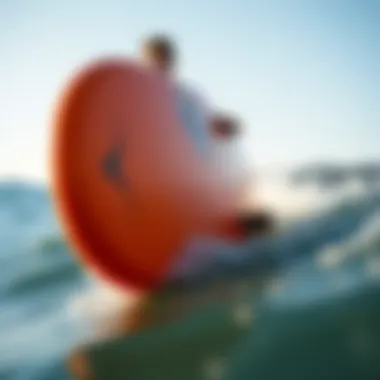
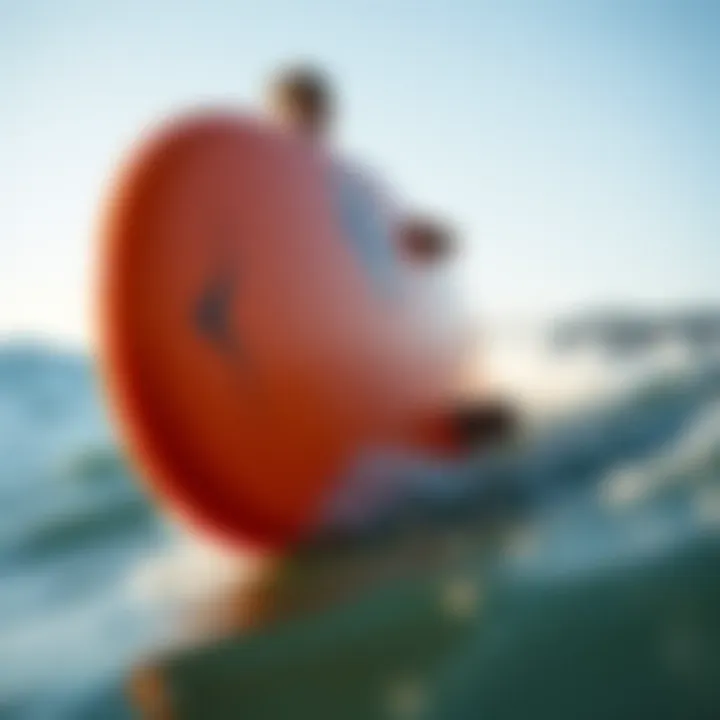
- Fiberglass is often the choice for durability and resistance to pressure, making it a top contender for avid skimboarders who value longevity in their equipment.
- Epoxy is lighter yet also robust, making it suitable for those who prefer a feather-like feel while still maintaining durability.
- Wood, while traditionally heavier, offers a particular aesthetic appeal and can be more forgiving for casual riders.
Each material serves different riding styles and preferences. For example, those favoring speed might go for epoxy, while slalom enthusiasts might stick with fiberglass.
Construction quality also plays a significant role. Stronger lamination and rigorous testing ensure the board can withstand the rigors of the surf. Some brands even incorporate environmentally friendly materials, showcasing a commitment to sustainability without sacrificing performance.
In summary, selecting the right materials and design in a 48-inch skimboard isn’t just a matter of preference; it profoundly impacts the overall skimming experience. These considerations allow users to find a board tailored to their unique riding style, enhancing both control and enjoyment on every wave.
Features of the Inch Skimboard
Delving into the features of a 48-inch skimboard reveals why this size is favored by many enthusiasts. The right features determine how a board performs and its suitability for different skimming environments. Understanding these aspects helps both new and experienced riders optimize their adventures, ensuring they choose a board that meets their unique needs.
Weight and Portability
When it comes to skimboarding, weight can make or break your experience. A 48-inch skimboard typically strikes a balance between durability and lightness. Most boards in this category weigh between 3 to 5 pounds, giving them enough heft to provide stability without exhausting the rider. This weight allows for easily transporting the board from the car to the beach, or wherever your adventure might take you.
Moreover, the dimensions of a 48-inch board also contribute to its portability. Being compact enough to fit into most car trunks, it gives travelers a convenient option for spontaneous outings. For the beach-goer, maneuvering the board through crowds or sand isn't a back-breaking ordeal. It’s much like carrying a medium-sized surfboard but without the cumbersome bulk.
"Lightweight boards help maintain your stamina, so you can keep skimming all day without feeling like you’re hauling around a small elephant!"
Surface Texture and Grip
Grip is essential in skimboarding, as it influences performance significantly. A good 48-inch skimboard should have a textured surface, often made from materials like foam or rubber. This texture enhances grip, allowing riders to stay steady while performing tricks or riding waves. There's nothing worse than losing your footing, right?
Also, some boards offer customizable grip options. Riders can often select the grip style that suits their preferences, whether they like a more aggressive texture or something smoother for riding on subtler waves. Getting this right is critical since it allows for more control over movements and techniques.
The grip also plays a crucial role when launching off the sand or into waves, ensuring that the rider feels confident with every push off the shore. The last thing anyone wants is to end up face-first in the sand.
Fin Setup and Customization Options
Skimboards come with different fin setups that can dramatically affect performance. In the case of a 48-inch model, riders might find options for single or multiple fins. A single fin setup is often preferred for beginners, providing more stability and easier maneuverability. In contrast, advanced users might opt for multiple fins to increase speed and control while executing tricks.
Customization doesn't stop there. Many boards allow riders to swap out fins according to their skill level or the specific conditions of the water. For instance, if the day calls for riding choppier waves, a specialized fin can be fitted for better performance.
This adaptability ensures that whether one is just starting or looking to push their limits, the 48-inch skimboard can adapt to their changing needs. A well-set fin system means fewer compromises on the water, leading to a far more enjoyable skimboarding experience.
Performance Aspects of a Inch Skimboard
Understanding how a skimboard performs is imperative for both beginners and seasoned riders alike. Performance elements such as speed, maneuverability, and suitability for various wave conditions greatly influence the skimming experience. In this section, we will dissect these performance aspects of a 48 inch skimboard, providing readers an in-depth look at what to expect and what to consider when selecting a skimboard for their needs.
Speed and Maneuverability
When it comes to skimboarding, speed is often the name of the game. A 48 inch skimboard is designed to glide smoothly over water, and an essential aspect of its performance lies in its ability to accelerate quickly. Generally, the design and materials of this size board provide excellent buoyancy, allowing riders to pick up speed with ease, especially in flat, shallow water.
Maneuverability is equally crucial. Riders need to navigate skillfully through waves, perform tricks, or simply change directions swiftly. Often, riders find that 48 inch boards, while providing good speed, can be slightly more challenging to maneuver than shorter boards. However, with practice, riders can learn to harness the speed for impressive stunts. Key factors affecting maneuverability include board shape, weight, and the rider’s skill level.
"Speed without control is like a wild horse without a rider." This saying captures the essence of mastering both speed and maneuverability in skimboarding.
Wave Conditions Suitability


Every skimboarder knows that picking the right board for the conditions can make all the difference. The 48 inch skimboard shines in moderately sized waves, typically around one to three feet tall. In these conditions, the board's length offers stability while enabling a fun ride.
For smaller waves, this board glides well, thanks to its surface area. However, when faced with larger waves, some riders may feel the need to switch to a shorter board, which can dip and weave more easily. Different riding styles also cater to various conditions; aggressive riders may prefer tighter turns, while cruisers seek lengthy runs without much fuss.
User Experience and Feedback
User feedback on 48 inch skimboards is a rich tapestry of personal experiences. Generally, beginners indicate that this size board offers a balance that helps them learn. The 48 inch dimensions allow for stability during those early attempts at skimming. Riders often remark about the comfort it provides while they gather skills and confidence.
More experienced user feedback frequently focuses on versatility. Many advanced skimboarders appreciate the boarding's length, describing how it complements their tricks and fluid style. For those who know what they’re doing, a 48 inch board serves as a trustworthy companion through different environments, whether they’re launching off a shore or overcoming challenging waves.
In summary, whether it’s the speed you can achieve, how easily you can change direction, or how well a board performs in certain wave conditions, these performance aspects significantly impacted riders' experiences. Understanding the nuances of each aspect prepares both newcomers and experienced skimmers to choose the right board and hit the waves like pros.
Selecting the Right Skimboard
Choosing the appropriate skimboard is an integral part of enhancing both performance and enjoyment on the water. It's not merely about snagging a board; it's about finding the right fit that aligns with one’s skill level, preferred style, and the locales where one skims. A well-selected skimboard can significantly affect the user experience—smooth rides, successful tricks, and increased confidence on the waves. In the following sections, we’ll break it down further.
Considerations for Beginners
For those just dipping their toes into skimboarding, understanding how to choose the right board can feel like finding a needle in a haystack. Here are some essential points to consider:
- Size and Weight: A 48-inch skimboard is often recommended for beginners due to its balance between stability and performance. It’s wide enough to provide a sturdy platform while remaining versatile enough to navigate different conditions.
- Material: Beginner boards are typically made of durable materials like foam or fiberglass, which offer a good mix of portability and resilience against nosedives or drops.
- Shape: Beginners might want to lean toward wider, flatter boards. They are easier to manage and provide better buoyancy when skimming over thin water.
As you're settling in, choosing a board with a greater amount of surface area will help in mastering basic techniques. It’s crucial not to overlook the importance of comfortable grip. A skidding board should offer materials that ensure safe footing, reducing the risk of slips.
Choosing for Intermediate and Advanced Users
For those who have already caught the skimboarding bug, selecting a board becomes a more tailored process. Here’s what to ponder:
- Performance Features: At this stage, it’s important to focus on fin setups and customization options. A more responsive skimboard, possibly featuring concave designs, can deliver precision for sharp turns and tricks.
- Material Upgrades: Intermediate and advanced skimmers may prefer lighter materials, like carbon fiber, to enhance performance while reducing drag. The right board should also allow for quick adjustments depending on the wave conditions.
- Shape Adaptations: Many experienced users may gravitate towards narrower, more streamlined boards, which offer better maneuverability for tricks and aerials. This shape can greatly increase control, essential for executing stunts and navigating through turbulent waters.
Assessing Brand Reputation
The brand you choose has a significant influence on the quality and performance of your skimboard. Here are a few pointers to help assess brand reputation:
- User Reviews: Platforms such as reddit.com and skimboarding forums can provide real feedback from actual users. Look for brands that consistently receive positive feedback.
- Brand Longevity: Established companies that have been around a while usually know their craft. Researching their history and track record can provide insight into their credibility.
- Customer Support and Warranty: Check if the brand offers a reasonable warranty and customer support. A reliable brand will stand behind its products and take care of its customers in the event of issues.
"A quality skimboard can often serve as your trusty companion during memorable summer days on the beach."
Techniques for Effective Skimboarding
Understanding the art of skimboarding transcends simply gliding over the waves. Developing effective techniques is pivotal for enhancing performance and maximizing enjoyment. For both newcomers and those with seasoned boards, having a grasp of the essential skills helps in tackling various surf scenarios. Whether you're just getting your feet wet or seeking to elevate your game, mastering these techniques is vital.
Basic Skimming Techniques
Before attempting any trick or maneuver, familiarizing oneself with the basic skimming techniques is key. Here are some foundational skills to start with:
- Running Start: Begin by sprinting towards the water with your skimboard in hand. Timing is everything. You should release the board just before reaching the waterline, allowing it to glide smoothly over the surface. The speed generated from your run is essential for a successful start.
- How to Position Your Feet: Keep your feet shoulder-width apart on the board. Your front foot should be positioned near the back for control, while the rear foot adjusts for balance. Finding the right stance can affect your overall stability.
- Weight Distribution: Shift your weight onto your back foot while skimming to maintain balance. Keeping your center of gravity low also helps in absorbing shock and adds to stability when riding.
"He who does not honor the roots of the sport, will not soar as high in the waves."
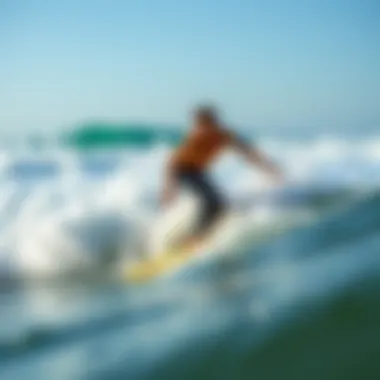
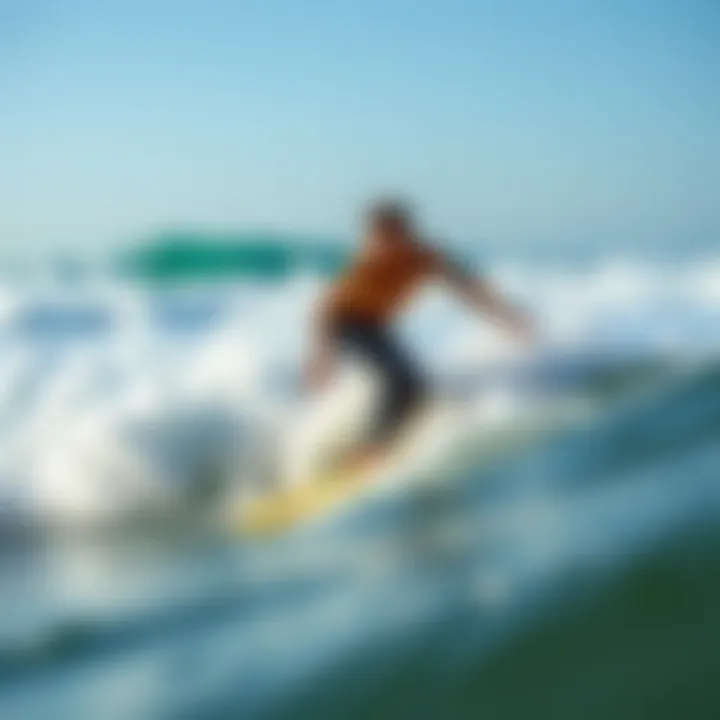
- Turning: To turn, lean your shoulders in the direction you want to go while pushing slightly with your back foot. Make slight adjustments to your foot position as necessary. Learning to turn effectively can open new routes in your skimming adventures.
Advanced Moves and Tricks
Once you’ve got a handle on the basics, it’s time to ramp things up. Advanced moves often require a mix of timing, precision, and likely, a bit of courage. Here are some techniques to consider:
- 360 Spins: This trick involves a full rotation on your skimboard. Initiate this move by doing a sharp turn while pushing hard with your back foot. It takes practice, but once mastered, the thrill is unmatched.
- Pop Shuvit: This involves popping the board off the water while spinning it underneath you. You need a solid grip with your feet and a precise lift at the right moment. Many find that practicing on flat surfaces before hitting the waves helps in perfecting this maneuver.
- Catching Air: Gain some speed and aim for ramps or small waves. As you approach, compress your knees slightly before launching off the edge. Timing your lift while extending your legs will help you catch air. Learning to land softly is crucial to avoid wiping out.
- Re-entry Moves: After catching air or turning, returning to the water gracefully is essential. Focus on adjusting your foot balance and allowing the board to naturally reconnect with the water. It’s all about finesse and precision as you glide back in.
As you develop these skills, always remember the importance of practice and patience. Perfecting techniques takes time, and the more you do it, the more natural it becomes. Immerse yourself in local skimboarding groups or online forums like reddit.com/r/skimboarding to gather more tips and experiences from other enthusiasts.
Each of these moves not only enhances your abilities but also adds excitement to your sessions. So, grab your 48-inch skimboard, head to the shores, and enjoy the ride!
Maintenance and Care for Your Skimboard
When it comes to owning a skimboard, especially one as popular as the 48-inch model, maintenance and care are paramount. Proper upkeep extends the life of your skimboard and enhances your overall skimming experience. A clean and well-maintained board performs better, allowing you to glide over the water and sand like a breeze. In this section, we will discuss essential cleaning and storage tips, alongside how to handle any mishaps—like chips or dents—that may occur in the course of your adventures.
Cleaning and Storage Tips
Keeping your skimboard clean is one of the easiest, yet often overlooked, ways to ensure it remains in top shape. After a day spent skimming, sand and salt can accumulate on your board, which might affect its performance and durability over time.
Here are some straightforward steps to follow:
- Rinse Immediately: After each use, it's wise to rinse your skimboard with fresh water. This simple act washes away the salt and sand that can corrode your board's materials. Use a hose or do it at the beach with a bucket—whatever works for you.
- Gentle Wipe Down: After rinsing, employ a soft sponge or cloth to wipe down the surfboard. Avoid abrasive materials as they can scratch the deck or underside. We're after a gentle touch, like a whisper.
- Dry Correctly: Place your skimboard in a shaded area to dry. Direct sunlight can warp the board, especially if it’s made of certain materials like foam or epoxy. Letting it air dry allows for evaporation while minimizing the risk of damage.
- Store Flat: When it's time to store your skimboard, always lay it flat and avoid stacking heavy objects on top. Storing it upright or leaning against a wall can lead to warping or cracking, and that's the last thing you want.
"Proper maintenance not only prolongs the lifespan of your skimboard but enhances performance; neglect it, and you might find yourself on a frustrating ride when it matters most."
Repairing Chips and Dents
Accidents happen, and even the most careful skimming can result in chips and dents. Addressing these issues before they worsen is crucial for maintaining your board’s integrity. Conducting repairs does not require a PhD in engineering but rather a bit of attention to detail. Here’s how to tackle common damage:
- Inspect Regularly: Make it a habit to check for any chips or dents after every session. Catching these early means you can fix them before they become larger problems.
- Classical Glue Solution: For minor chips, you can often use a strong adhesive, like epoxy, to fill in these gaps. Apply it generously and smooth it out with a plastic spatula. Ensure it dries according to package instructions.
- Sand to Smoothness: Once the repair material has fully cured, use fine-grit sandpaper to smooth out any rough patches. It’s akin to giving your skimboard a little hairstyle makeover.
- Professional Help: If the damage is extensive, such as major cracks or delamination, seeking professional repair services may be the best route. Many local shops specialize in board repair, making it worthwhile to invest a little in restoring your beloved skimboard.
By adhering to these maintenance protocols, you protect your investment and the sheer joy of skimboarding. Each wash, repair, and careful storage strategy are steps toward keeping your 48-inch skimboard ready for those sunny days at the beach.
The Future of Skimboarding
The future of skimboarding stands at an intriguing crossroads, with the potential for technological advancements and changing cultural dynamics playing critical roles. As more people dive into the sport, the possibilities for innovation, creativity, and community growth become more apparent. Technology has already started to reshape how skimboards are designed and utilized, making the experience more accessible and enjoyable for enthusiasts at every skill level. Moreover, the culture surrounding skimboarding is evolving as new communities emerge and existing ones become knit closer through shared experiences and social media. Understanding these elements is key to appreciating where this thrilling sport might head in the years to come.
Technological Innovations in Board Design
Emerging technologies present a fertile ground for innovation in skimboard design. New materials and techniques are allowing manufacturers to create boards that are not only lighter and stronger but also more adaptable to varying conditions. For instance, boards made from advanced composites, like carbon fiber or epoxy, deliver exceptional performance with a minimum weight. The focus is shifting not just to the durability but also to performance optimization.
Some companies are now experimenting with 3D printing to create custom-fit boards tailored to specific riders’ needs, potentially revolutionizing the market. This sort of personalization allows skimmers to have boards that suit their unique styles and body types, improving their overall experience on the water. Furthermore, better hydrodynamic designs are increasing glide and maneuverability, adding a new dimension to performances and tricks.
"The integration of tech into skimboarding is paving the way for customizability and performance that we didn't think was possible just a few years ago."
With brands like C-Flat and Banshee spearheading these innovations, it becomes clear that the future of skimboarding lies in a blend of science and adventure. Riders can look forward to even more advanced fin setups and modular board systems that let them tailor their equipment for specific wave conditions or personal trick preferences. The potential for creativity and exploration is virtually limitless.
Skimboarding Community and Culture
The culture surrounding skimboarding is a vibrant tapestry woven from the threads of different backgrounds, experiences, and shared love for the sport. As more enthusiasts join the ranks, the desire for community connection has intensified. Social media platforms such as Facebook, Instagram, and Reddit have become hotbeds for discussion, inspiration, and learning, allowing people from all corners of the globe to share tips, video tutorials, and stories.
Events like skimboarding competitions and beach festivals not only showcase talent but also foster camaraderie among skimmers. These gatherings provide opportunities for riders to test their skills, meet like-minded individuals, and build friendships. Additionally, local shops and rental services are increasingly catering to the growing demand for skimboarding equipment, further solidifying the culture’s presence in popular outdoor lifestyles.
As social awareness surrounding environmental issues increases, the skimboarding community is stepping up to make a mark. Many riders are advocating for clean beaches, ocean conservation, and sustainable practices within the sport. By promoting awareness and encouraging eco-friendly habits, the community sets an example for future generations of skimmers.
All these aspects suggest that the culture of skimboarding is not just about riding waves; it’s about building connections, sharing knowledge, and giving back to the environment. As we look ahead, it's clear that the future of skimboarding is not just anchored in the sport itself but in the community and culture that supports it.







